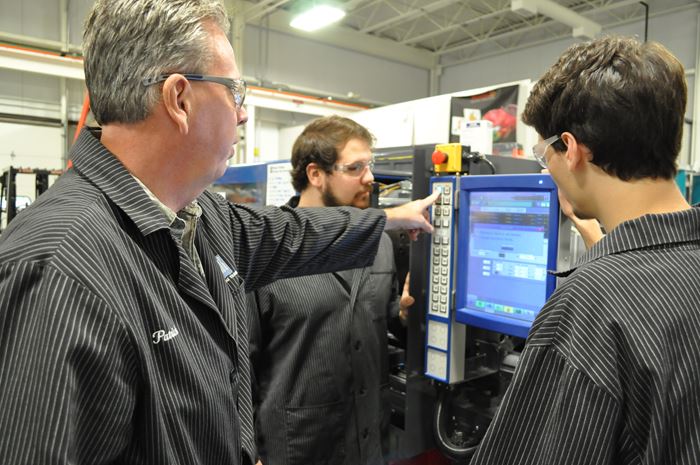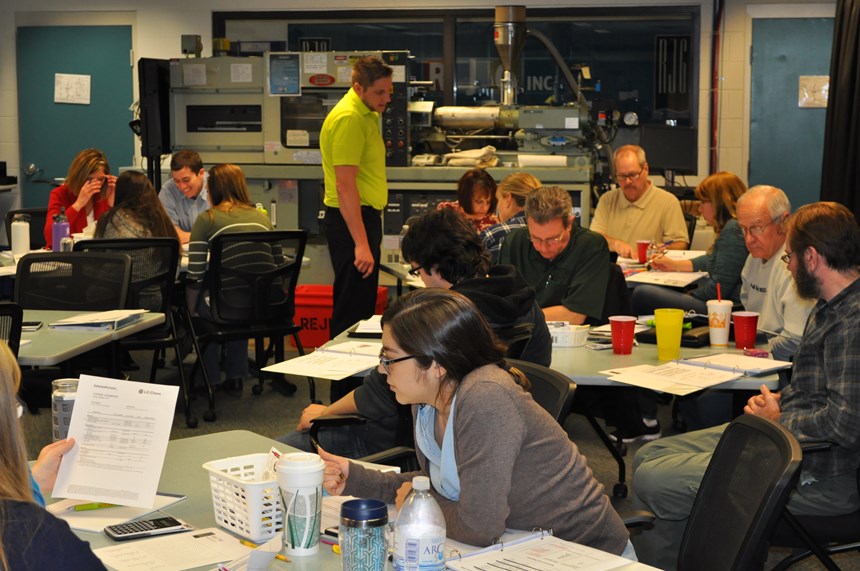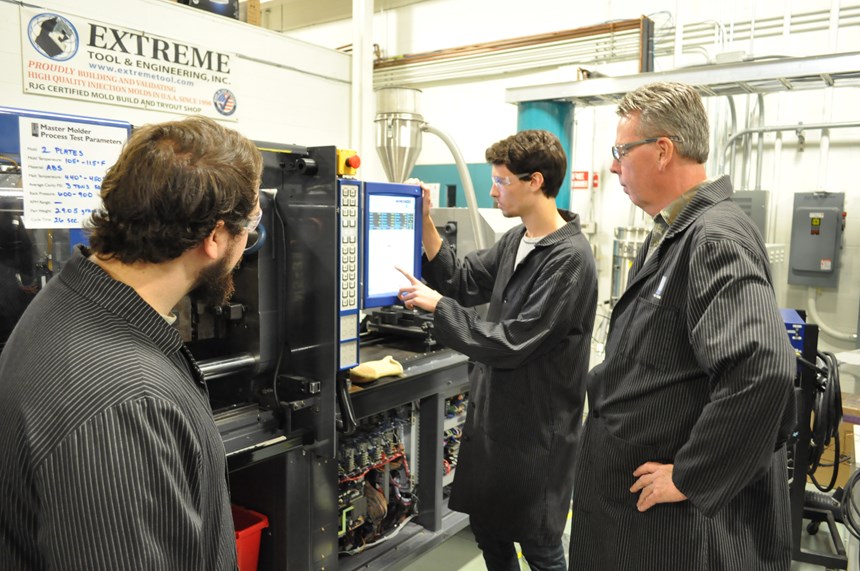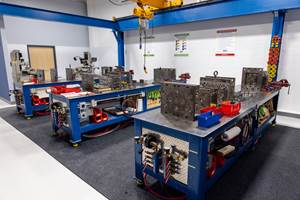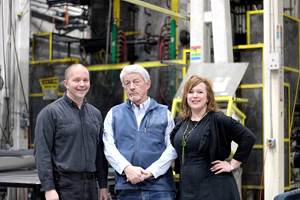Molding Better Molders, One Class at a Time
Founded by and named for Rod Groleau, RJG grew out of an appreciation for two burgeoning needs of the plastics industry: training to help people better understand the molding process and equipment to let them actually see what’s happening inside that process.
To address the first need, Groleau started RJG Associates as a training and consulting firm in 1985. That was followed in short order in 1989 by the creation of RJG Technologies as an equipment company supplying sensors and data-acquisition systems. The two units merged into RJG Inc. in 1999 to provide molders with technology and training.
In late August, I visited RJG’s headquarters in Traverse City, Mich. on the shores of Lake Michigan’s Grand Traverse Bay, to acquaint myself with the training portion of the company’s business, taking part in a 3-day Systematic Molding class. My classmates numbered 13 and were diverse in age (20’s to 50’s), markets served (medical, automotive, and pipe fittings) and geographic base (Alabama, Michigan and Hungary).
Our teacher, Patrick Mosley, has 32 years of training, including 24 with RJG. Mosley studied drafting in school and originally instructed on the use of machine tools. When Groleau wanted to set up a tool room at RJG, he asked Mosley for assistance, and that work eventually lead to him becoming an RJG instructor.
The week prior to our Systematic Molding class, Groleau, who remains active with the company, was in the offices in Traverse City. Mosley reminisced about his teaching style. Perched on the edge of a desk, Groleau would ultimately cover all the information in the text, but how it was covered was different with each class.
Regardless of the experience or background we brought to the training, all students are issued the same “equipment” for the class—calculator, multicolor pen, mechanical pencil, highlighter, pad of sticky notes, legal pad, 7-inch ruler, laminated card with common equations, a spiral-bound Systematic Molding course manual and a teaching part showing various common molded part facets like bosses, walls and snapfits, some of which were designed well and others that were designed poorly.
While students settle in and all who are registered arrive, we work on a plastics-themed word search—hidden terms include crystalline, drooling, short shot—to kill some time. Roll is taken, and we immediately begin an assessment test to gauge our initial knowledge of plastics and molding. This evaluation covers the major topics tackled in the class: machine, mold, materials, process and part design.
Within process, the four major plastic variables—cooling, pressure, flow and heat—are addressed. At the end of each unit in the course book, a review quiz is given that matches the representative section from the assessment test. Upon course completion, students can see what knowledge they came in with and what new information they leave with.
Carpet Guys and Concrete Guys
Over more than 30 years of training, Mosley has accumulated three things in abundance: parts, equipment and other props he pulls from boxes as visual aids; anecdotes from the classroom at RJG as well as various companies he’s visited in support of training and installation of RJG technology; and expert level local-tour-guide knowledge of Traverse City. He jokes how companies can be split into concrete guys (people on the shop floor) and carpet guys (people in the administrative office). This group is very much a concrete one.
At lunch, students have an hour to feed themselves, and Mosley walks over to two maps of Traverse City and the surrounding area posted on the door to the classroom, pointing out numerous restaurants and sights, including the location of vacation homes for various celebrities that frequent the resort town. As class wraps up in the afternoon, he again revisits the map, pointing out good spots for dinner and drinks.
All of this real-world knowledge—whether it’s the best barbeque in town or what happens when POM and PVC mix (it’s not good)—is interspersed into the lessons. Course concepts are reinforced through stories. Eventually the students share their own hard-learned lessons from the shop floor and bonding by commiseration ensues. The spirit of those early classes lead by Groleau, which may have digressed into tangents while still covering all the core material, remains to this day.
Students are spread among three tables. Mosley works from a lap top projecting the manual onto a screen with a white board behind. He retracts the screen from time to time to hand annotate onto the projections, which are now illuminated on the white board. At various points, he almost forgets to draw up the screen, nearly defacing it with dry-erase marker. Times when Mosley or other instructors didn’t catch themselves are evident on the screen in the form of blobs of whiteout. On the side of the classroom where students enter is a 1989 Nissei injection molding machine, outfitted with RJG equipment, including an eDART®. The machine looks its age but works, according to Mosley. “It takes a littler longer to warm up,” Mosley explains, “like older people.”
Why You’re Here
“Do you all know why you’re here or did they just say go to training?” Mosley asks on the morning of the first day. All of the students do, including two who have traveled from Hungary for the course. They are starting with Systematic Molding but will be moving into Master Molder training. Eventually the overseas students will teach Mosley and the class something—how to say no in Hungarian—'nem.’ Some students had come from other industries and were looking to better understand plastics. Some younger attendees, as well as their supervisors back at their plants, saw a path for them to advance in molding and registered them for the course to start them down that track.
The core focus of the course is visually distilled into a graphic familiar to many in molding. Four puzzle pieces bearing the words: part design, material, mold and machine, enclose a fifth puzzle piece—process—in the center. Early in the discussion of materials, the class gets interactive. Students are given piles of paper clips and put into pairs. One student hands the other paper clips, which that student then links together. This is done for a set amount of time and then the roles are reversed. The resulting chains are then strung individually from magnets on the dry-erase board at the front of the room. It’s immediately apparent that the length of chain created by some students far exceeds that of others. The point of the exercise was to show how despite the same process and the same inputs, paper clip chain length in the class room (and polymer chain length in a reactor) can be wildly different. Variable chain lengths, and therefore different molecular weights, in polymers mean different properties in parts and, for the purposes of class, different viscosities in processing.
Lab Time
At various points, the class heads to RJG’s in-house molding lab featuring eight fully equipped injection molding machines. At the press, Mosley shows students how to perform various studies that will help set up a process, including injection speed linearity. This builds up to the afternoon of the final day, which is completely devoted to lab work.
In addition to all the equipment you’d find on any shopfloor, the lab has some vivid examples of molding gone wrong. Stalactite-shaped masses of plastics formed unintentionally by students in Master Molder courses. In addition to getting the back stories on these experiments gone awry, students help gather numerous data points, from part weight and plastic pressure to transfer position and time, as they create their own set up sheet.
Gathering and manipulating that data via various equations is a recurrent theme for the class. That should have been obvious when three of the items students are first supplied include a ruler, a calculator and sheet of common equations, but I for one didn’t appreciate just how much math is involved in injection molding. (RJG actually offers a Math for Molders online course). Through much of the class the clacking sounds of students punching out equations on their calculators can be heard.
As the class progresses, students become more willing to answer Mosley’s questions, even those that require some math. When the class is stumped, Mosley guides the students to the answer versus just giving it to them. At this point, the students are also bringing the coursework back to the molding world they’ll be returning to, thinking about how what they’re learning in Traverse City applies to the machines and applications that are waiting from them back home.
Newly Minted Molding Scholars
After three days and once the class is completed, students are presented a certificate, marking their ‘graduation.’ For many, this will be the first step on a path of deeper molding education, including Master Molder training that many were already looking at. Earlier in the class, Mosley asked the students how many had gone to school for injection molding and no hands went up. Completion of a three-day course doesn’t equate to a college degree, but even among schools that offer polymer engineering, not too many offer injection molding specific coursework. After three days in Traverse City, that same question posed to this group would produce 13 raised hands.
Related Content
American Injection Molding Institute Opens Mold Maintenance Classroom
The Beaumont subsidiary has opened the Mold Maintenance Center of Excellence classroom at its Erie, Pennsylvania, headquarters.
Read MoreBlow Molder Confer Plastics Celebrates Golden Anniversary & the ‘American Dream’
This family-run firm fills a specialized niche with a culture of innovation and environmental stewardship that realizes the dreams of its founders, its employees and its customers.
Read MoreEducating the Next Generation of Plastics Professionals
These schools and local industry are working together to close the workforce gap in the plastics industry by offering hefty plastics curricula and training programs for degree-seeking students as well as current plastics employees looking to upskill.
Read MorePaulson Training Acquired
Certus, a technical skills training business and portfolio company of private equity firm Ridgemont Equity Partners, has acquired the plastics processing training business founded in 1981.
Read MoreRead Next
Beyond Prototypes: 8 Ways the Plastics Industry Is Using 3D Printing
Plastics processors are finding applications for 3D printing around the plant and across the supply chain. Here are 8 examples to look for at NPE2024.
Read MoreFor PLASTICS' CEO Seaholm, NPE to Shine Light on Sustainability Successes
With advocacy, communication and sustainability as three main pillars, Seaholm leads a trade association to NPE that ‘is more active today than we have ever been.’
Read MoreLead the Conversation, Change the Conversation
Coverage of single-use plastics can be both misleading and demoralizing. Here are 10 tips for changing the perception of the plastics industry at your company and in your community.
Read More

